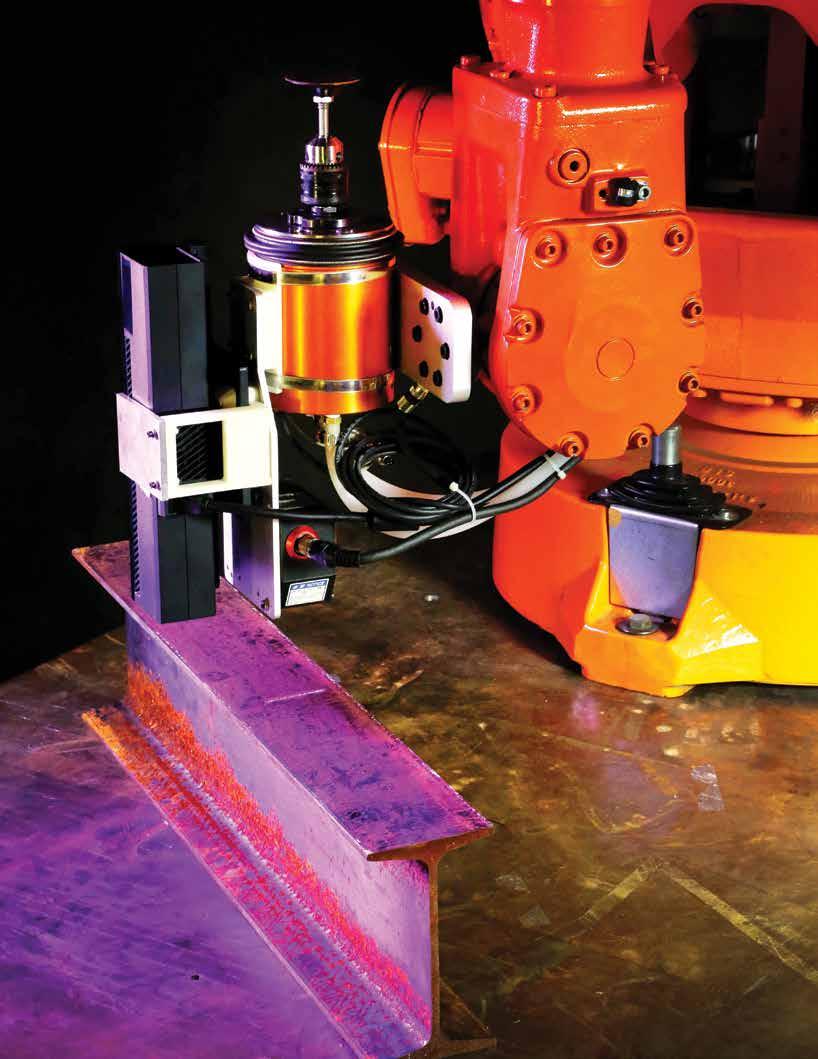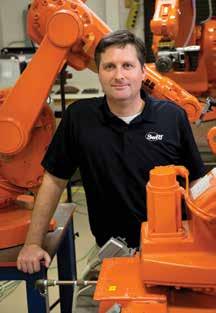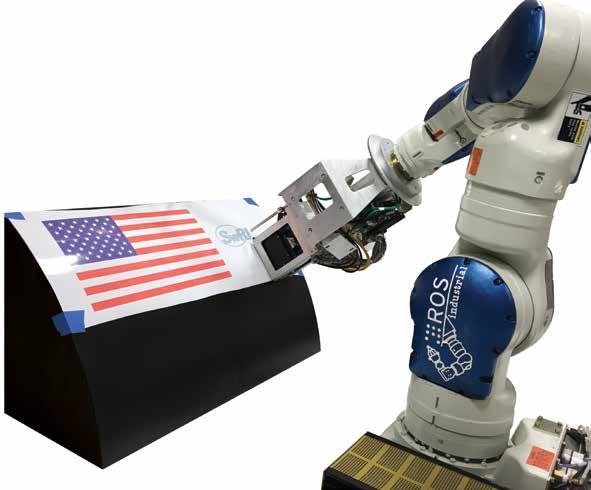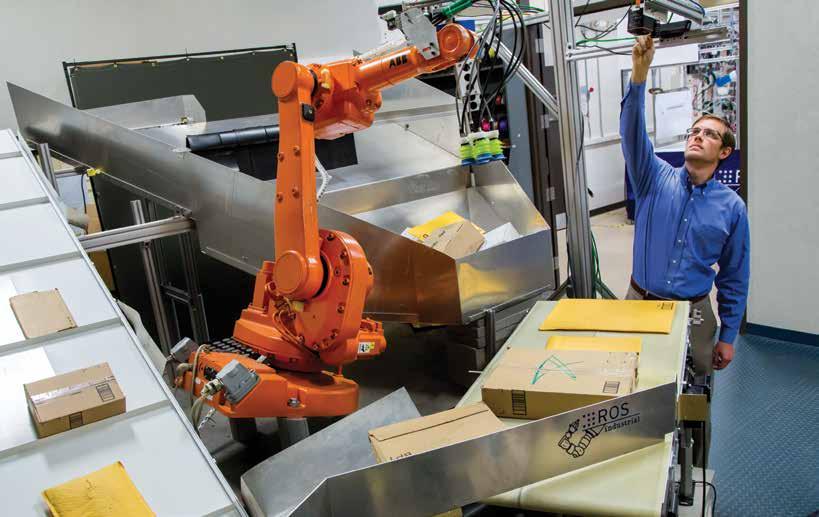
7 minute read
Smarter Automation
BLAZING A TRAIL FOR SMARTER, MORE AGILE AUTOMATION
By Paul Evans

Paul Evans directs SwRI’s Manufacturing Technologies Department. This group uses new technologies to enable advanced industrial applications, developing and implementing innovative electromechanical systems and adaptive software solutions. Evans has conducted robotics and automation programs for a variety of clients and industries, including food manufacturing, automotive, aerospace, material handling, and packaging.
Industrial robots usually call to mind the image of an articulated arm bolted to a factory floor, its end-effector “hand” pivoting to spot-weld automobile bodies as they slide past, one by one, on an assembly line.
That’s nowhere near the image that the robotics community has in mind for future industrial automation. These robots will be mobile, agile, and adaptive. They’re not rooted to a floor; on the contrary, these robots can navigate through their workspace. They use machine vision and GPS-like location to interact with objects and understand where they are within their environment. These robots understand tools and their capabilities and are able to apply them automatically to new tasks. And when the work is done, robots can be sent to do a different job, with different tools.
Robotics researchers also want their new machines to “speak” the same robot language as a host of other robots worldwide. Rather than being a trade secret, the language would be open-source and accessible to programmers of a broad range of robots, so everyone can benefit from that common language.
All of this isn’t just a wish list or some far-off utopian vision: It’s already in development today at Southwest Research Institute. In fact, researchers in the Intelligent Systems Division have spent nearly three decades developing software to make industrial robots smarter. SwRI also has been instrumental in developing, proliferating, and curating ROS-Industrial (ROS-I). This open-source framework is designed to build an international community around the advanced Robot Operating System known as ROS for industrial applications.
Over just five years, manufacturers and suppliers have adopted ROS-I for applications ranging from robots that dynamically sort cluttered objects, to ones that can paint arbitrary objects, to robots that move autonomously inside a warehouse or factory while avoiding obstacles.
MILITARY INTEREST IN ROBOTICS
The prospect of developing intelligent, multitasking robots has caught the interest of the military as well. The U.S. Air Force recently assembled a team of SwRI, the Boeing Company, and the National Center for Defense Manufacturing and Machining (NCDMM) to make advanced robotics reusable for aerospace maintenance and manufacturing. NCDMM is managing the four-year, $6.7 million contract. Boeing is providing process development and tooling expertise, while SwRI is developing a general-purpose software framework using ROS-I and will integrate all the subsystems on a large mobile robotic demonstration platform.

SwRI has patented a large-scale robotic technique for inkjet printing intricate graphics on aircraft and other complicated surfaces, shown here in a laboratory-scale demonstration.
The Air Force Research Laboratory (AFRL) challenged the team to develop and demonstrate a mobile multiprocess robotic solution through the Advanced Automation for Agile Aerospace Applications (A5) program. The objective: Make it easier to use one piece of machinery to transition from one manufacturing or maintenance task to another, quickly and cost-effectively, without engineering or programming rework between tasks.
Traditional manufacturing automation tends to rely on purpose-built machines, typically dedicated to a specific aircraft or component. Those machines demand large initial capital outlays and significant operating expenses; adaptation is costly and innovation is slow.
The A5 program aims to upend that paradigm using ROS-Industrial to develop flexible technology that can be used across different manufacturing processes and environments. Phase 1 will develop adaptive robotic capabilities in aircraft sanding. Phase 2 will apply those capabilities to composite aircraft repair, and Phase 3 will develop nondestructive capabilities using the same mobile platform.
Using ROS-I, the team can dramatically reduce the amount of manual programming and intervention needed to implement advanced automation.
A HISTORY OF SMARTER ROBOTS
Using advanced automation to solve military maintenance challenges is nothing new at SwRI. The drive toward smarter industrial robots for military aerospace tasks began more than 30 years ago with an automated process to polish away scratches in the clear-composite cockpit canopies of F-16 fighter aircraft. Later, SwRI was active in developing robots to remove coatings from F-15 fighters. For modern aircraft and aerospace systems, it’s important that the robot remove paint without damaging the underlying composite materials that make up large portions of today’s aircraft. Such a system saves time and money while providing consistent quality, but perhaps most significantly, it can improve worker welfare by removing them from hazardous environments.
Continued research at SwRI has refined the robotic coating removal process itself, from blasting plastic particles onto a surface to vaporizing layers of coating material using precisely focused lasers. New, state-of-the-art laser coating removal (LCR) technology is being developed for a commercial client. The system combines a mobile robotic platform, laser scanning technology, and high-powered lasers for safe and efficient removal of paint and other aircraft coatings.

SwRI developed this mobile manipulator platform to evaluate new robotic applications. The technology is applied to automate warehouse operations and to adapt navigation strategies for SwRI’s large-scale aerospace robotics programs.

This illustration depicts how a robotic arm commonly used in advanced manufacturing can be adapted to perform multiple functions such as under-wing sanding or composite repair on military aircraft.
Significantly, the LCR process uses a high-speed vision system to precisely control the coating removal. This provides the capability to remove the coating layer by layer, down to the base material, or leaving the primer intact. It’s particularly well-suited to today’s modern airframes constructed from sensitive substrate materials.
TEACHING A ROBOT NEW TRICKS
Responding to needs in the aerospace industry, SwRI researchers recently added yet another application for large-scale robots. They patented a technology for inkjet printing on rounded surfaces such as aircraft fuselages.
As aircraft decorative coatings have become increasingly complex, the aircraft manufacturing and maintenance communities are seeking more efficient ways to apply complex graphics. To fully leverage the potential efficiency and aesthetic advantages, the inkjet process must be able to print on a variety of complex geometries and in varied orientations, over large areas.
Inkjet printing provides the potential for superior performance compared to decals or appliqués, which are difficult to qualify due to adhesion and robustness issues over the wide range of speeds and environmental conditions associated with flight.
The inkjet system, developed with internal funding by SwRI, needed to overcome challenges associated with large, complex surfaces to be painted, as well as inaccuracies in robot positioning and vibration of robot structures. Inkjet, also known as direct printing, allows for digitally printing complex graphics on everything from textiles to billboards. The SwRI-developed system expands that capability to aircraft fuselages, wings, tail fins, and engine nacelles, replacing labor-intensive traditional painting techniques.
SwRI’s research culminated in being awarded U.S. Patent No. 9,527,275, “High Accuracy Inkjet Printing.” The patent covers hardware and software for precise application of multiple graphic swaths of color ink onto complex surfaces, creating a continuous graphic image. Each pass of color, or graphic swath, can be aligned over curved surfaces without spaces, gaps, or discontinuities.
A vision sensor will detect an encoded pattern to ensure accurate application of graphic images. The encoded pattern will be deposited on the surface in a known location with respect to the most recently deposited graphic swath. The printing system includes high-bandwidth servo actuators to locate the print head with respect to the encoder pattern to permit precise positioning for the next swath.

SwRI specializes in integrating unique sensor solutions into existing manufacturing processes and developing control methodologies to automate processes. Here, engineers have developed a robotic system incorporating machine vision to automate a package sorting system.
TAKING ROS-I TO THE WORLD
All of these initiatives draw upon the resources and ingenuity of the ROS-I community, a diverse group of experts in academia and industry that is advancing secure and open-source robotics.
SwRI maintains the ROS-I software repository and coordinates the ROS-Industrial Consortium (RIC), which has more than 50 members from academia and industry around the world. Launched in 2013, RIC has three branches, with SwRI leading RIC-Americas and Fraunhofer IPA in Stuttgart, Germany, leading RIC-Europe. In 2016, RIC expanded into the Asia-Pacific region with the Singapore-based Advanced Remanufacturing and Technology Centre and Nanyang Technological University launching RIC-Asia Pacific. RIC supports the ROS-I community and focuses on training, technical support, and setting the strategic roadmap for ROS-I.
ROS-I is revolutionizing robotics and their use in advanced manufacturing. Capabilities include collision-free and advanced path planning, software reuse across robot brands, and easy integration of the latest sensing technologies. ROS-I also allows rapid prototyping for new applications and provides a bridge to other frameworks such as PackML, MTConnect, and many others. SwRI is leading the charge, using ROS-I as a springboard to create tomorrow’s smart, dexterous robots for applications from the factory floor to military maintenance depots and beyond.
This story was originally published in Industry Today, Volume 20, Issue 1.
Questions about this article? Contact Evans at (210) 522-2994 or paul.evans@swri.org.

In 2011, SwRI installed this largest-ever dual robot system to use plastic media blasting to remove coatings from Air Force fighter jets. Engineers also used the system to conduct a large-scale demonstration of a high-speed laser coating removal technology, a more environmentally friendly alternative to current chemical and blast removal methods. SwRI is currently developing a laser-based coating removal system deployed on a mobile robotic platform for a commercial client.




